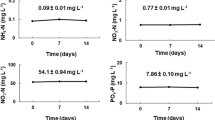Abstract
Gracilaria is a potentially valuable source of marine biopolymers such as proteins and polysaccharides. In order to select suitable culture conditions, growth and tolerance of Gracilaria chorda Holmes from Shikoku Island in southwest Japan were investigated under variations of temperature (5–30 ∘C), photon irradiance (20–120 μmol photons m−2 s−1), and photoperiod (12:12 h, 14:10 h light:dark regime) in a unialgal culture. Gracilaria chorda showed wide tolerances for all factors investigated, which is characteristic of eurythermal species. Maximum growth was observed at 18–24 ∘C. The optimum photon irradiance for the algal growth was 60–120 μmol photons m−2s−1. Instead of using ordinary sea salt (NaCl) to prepare artificial seawater, ultra pure salt was adopted. Gracilaria chorda grew faster in artificial seawater made with ultra-pure salt than that made with ordinary sea salt, probably because the former medium was clear, while the latter was milky. Effects of some metal ions on the growth were tested with artificial seawater. Iron ions affected algal growth, but cobalt ions did not. This study enables us to determine suitable culture conditions for G. chorda. A scaled-up 30 l culture of G. chorda under such conditions was successful.
Similar content being viewed by others
References
Beer S, Levy I (1983) Effects of photon fluence rate and light spectrum composition on growth, photosynthesis and pigment relations in Gracilaria sp. Journal of Phycology 19: 516–522.
Bird NL, Chen LCM, McLachlan J (1979) Effects of temperature, light and salinity on growth in culture of Chondrus crispus, Furcellaria lumbricalis, Gracilaria tikvahiae (Gigartinales, Rhodophyta) and Fucus serratus (Fucales, Phaeophyta). Bot. Mar. 22: 521–527.
Bird KT, Ryther JH (1990) Cultivation of Gracilaria verrucosa (Gracilariales, Rhodophyta) strain G-16 for agar. Hydrobiologia 204/205: 347–351.
Chirapart A, Ohno M, Sawamura M, Kusunose H (1994) Effect of temperature on growth rate and agar quality of a new member of Japanese Gracilaria in Tosa Bay, southern Japan. Jpn. J. Phycol. 42: 325–329.
Gessner F (1970) Temperature. Plants. In Kinne, O. (ed.), Marine Ecology, Wiley-Interscience, London: PP. 363–406.
Gessner F, Schramm W (1971) Salinity. Plants. In Kinne, O. (ed.), Marine Ecology, Wiley-Interscience, London: pp. 705–820.
Hoyle MD (1978) Agar studies in two Gracilaria species (G. bursapastoris (Gmelin) Silva and G. coronopifolia J. Ag.) from Hawaii. II Seasonal aspects. Bot. Mar. 21: 347–352.
Kakita H, Kamishima H, Ohno M, Chirapart A (2003) Marine biopolymers from the red algae, Gracilaria spp. In Fingerman M., Nagabhushanam R. (eds), Recent Advances in Marine Biotechnology. Volume 9. Biomaterials and bioprocessing. Science Publishers Inc., Enfield, NH: pp. 79–109.
Kain JM (1987) Seasonal growth and photoinhibition in Plocamium cartilagineum (Rhodophyta) off the Isle of Man. Phycologia 26: 88–99.
Lahaye M, Yaphe W (1988) Effect of seasons on the chemical structure and gel strength of Gracilaria pseudoverrucosa agar (Gracilariaceae, Rhodophyta). Carbohydrate Polymers 8: 285–301.
Laing WA, Christeller JT, Terzaghi BE (1989) The effect of temperature, photon flux density and nitrogen on growth of Gracilaria sordida Nelson (Rhodophyta). Bot. Mar. 32: 439–445.
Lapointe BE (1981) The effects of light and nitrogen on growth, pigment content and biological composition of Gracilaria foliifera v. angustissima (Gigartinales, Rhodophyta). Journal of Phycology 17: 90–95.
Lapointe BE, Tenure KR, Dawes CJ (1984) Interactions between light and temperature on the physiological ecology of Gracilaria tikvahiae (Gigartinales: Rhodophyta). Marine Biology 80: 161–170.
Lobban CS, Harrison PJ (1994) Seaweed Ecology and Physiology, Cambridge University Press, Cambridge: 366 PP.
Luhan MRJ (1992) Agar yield and gel strength of Gracilaria heteroclada collected from IIoilo, central Philippines. Bot. Mar. 35: 169–172.
Lüning K (1981) Light. In Lobban, CS, Wynne MJ (eds), The Biology of Seaweeds, Blackwell Scientific Publications, Oxford: pp. 326–355.
Matsunaga K, Nigi G, Suzuki Y, Yasui H, Deein G (1998) Effect of fulvic acid-Fe derived from the forest on the growth of Laminaria religiosa Miyabe and Undaria pinnatifida Suringar. Bulletin of Society of Sea Water Science Japan 52: 315–318.
Niino Y, Nishimura H, Arita M (1992) Studies on drying temperature conditions for measuring loss of mass on drying of common salt transition temperature of salt hydrates. Bulletin of the Society of Sea Water Science Japan 46: 150–157 (in Japanese with English abstract).
Niino Y, Nishimura H, Arita M (1993) The formation of hard-to-dissolve matter in dry salt. Bulletin of the Society of Sea Water Science Japan 47: 74–80 (in Japanese with English abstract).
Orsco CA, Ohno M (1992) Growth rates of Gracilaria species (Gracilariales, Rhodophyta) from Tosa Bay, southern Japan. Japanese Journal of Phycology (Sorui) 40: 239–244.
Oza RM (1978) Studies on Indian Gracilaria. IV. Seasonal variation in agar and gel strength of Gracilaria corticata J. Ag. occurring on the coast of Veraval. Bot. mar. 21: 165–167.
Provasoli L (1968) Media and prospects for the cultivation of marine algae. In Watanabe A, Hattori A. (eds.), Cultures and collections of Algae, Japanese Society of Plant Physiology, Tokyo: pp. 63–75.
Whyte JNC, Englar JR, Saunder RG, Lindsay JC (1981) Seasonal variations in the biomass, quantity and quality of agar, from the reproductive and vegetative stages of Gracilaria (verrucosa type). Bot. Mar. 24: 493–501.
Winer BJ, Brown DR, Michels KM (1991) Statistical principles in experimental design, third edition, McGraw-Hill, New York: pp. 153–198.
Yamamoto H, Sasaki J (1987) Cross experiment between so-called Gracilaria verrucosa (Huds.) Papenfuss from two localities, Shinori and Kikonai in Hokkaido. Bull. Fac. Fish. Hokkaido 38: 1–4.
Yenigul M (1993) Seasonal changes in the chemical and gelling characteristics of agar from Gracilaria verrucosa collected in Turkey. Hydrobiologia 260/261: 627–631.
Yokoya NS, Kakita H, Obika H, Kitamura T (1999) Effects of environmental factors and plant growth regulators on growth of the red alga Gracilaria vermiculopylla from Shikoku Island, Japan. Hydrobiologia 398/399: 339–347.
Yokoya NS, Oliveira EC (1992) Temperature responses of economically important red algae and their potential for mariculture in Brazilian waters. J. Appl. Phycol. 4: 339–345.
Author information
Authors and Affiliations
Corresponding author
Rights and permissions
About this article
Cite this article
Kakita, H., Kamishima, H. Effects of Environmental Factors and Metal Ions on Growth of the Red Alga Gracilaria Chorda Holmes (Gracilariales, Rhodophyta). J Appl Phycol 18, 469–474 (2006). https://doi.org/10.1007/s10811-006-9047-5
Published:
Issue Date:
DOI: https://doi.org/10.1007/s10811-006-9047-5




